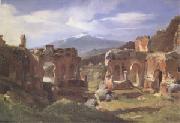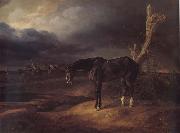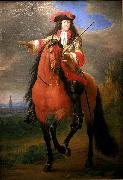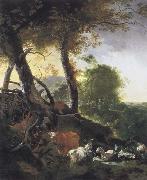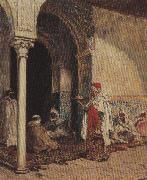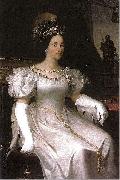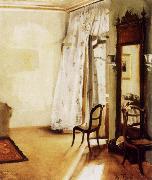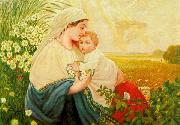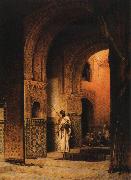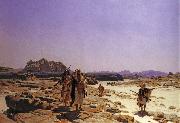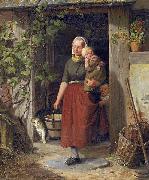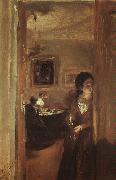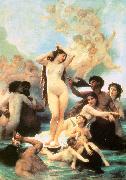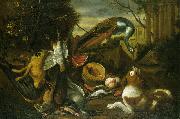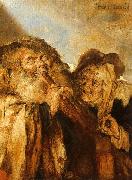|
|
 |
Aby Altson
|
|
Australian Classicist Painter,
1864-1949 |
|
|
|
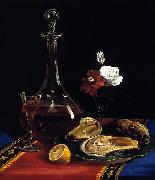 |
Adalbert John Volck
|
|
Adalbert J. Volck (1828 - 1912) was a dentist, political cartoonist, and caricaturist born in Bavaria. He was known for supporting the Confederacy during the American Civil War, doing so through his political cartoons (below), smuggling items for the Confederate army, and personally assisting President Jefferson Davis by acting as a courier.
Volck was also known for his work on porcelain restoration techniques in dentistry. |
|
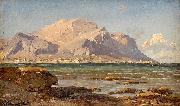 |
Adalbert Waagen
|
|
painted Bucht von Palermo mit Blick auf Monte Pellegrino in 1896 |
|
|
|
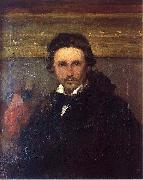 |
Adam Chmielowski
|
|
1845-1916) was a Polish religious brother and founder of the Albertines. He is a saint of the Catholic Church. Albert is also known as Brat Albert (Brother Albert); in recognition of his holiness he has also been called the "Brother of Our Lord", "Brother of Our God", and "Our God's Brother".
Adam Chmielowski was born to a wealthy aristocratic family, and initially studied agriculture with the intention of managing the family estate. Involved in politics since his youth, he lost a leg at the age of 17 while fighting in an insurrection. He became a well-known and well-liked artist in Krakew, his political convictions inspiring his interest in the human condition. A gentle and compassionate spirit, Chmielowski felt compelled to help those in need and after years of reflection, decided to follow his calling into the service of God.
In 1880, Chmielowski joined the Jesuits, took up the name Albert and abandoned painting. He began a life of service to the poor. In 1887, he founded the Brothers of the Third Order of Saint Francis, Servants of the Poor, known in honor of their founder as the Albertines or the Gray Brothers, after their rough gray habits. In 1891, he founded the women's congregation, the Gray Sisters. The Albertines organized food and shelter for the poor and homeless. |
|
|
|
|
|
|
|
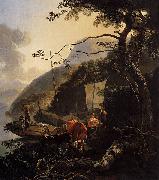 |
Adam Pijnacker
|
|
15 February 1622, Schiedam - buried 28 March 1673, Amsterdam ) was a Dutch Golden Age painter, mostly of landscapes.
Pynacker was the son of a wine merchant, who was a member of the vroedschap, or city regency. He travelled to Italy and was gone for three years. In 1658 he converted to Catholicism in order to marry Eva Maria de Geest, Wybrand de Geest's daughter. In that year his portrait was painted by his father-in-law. In Schiedam he baptized two children, but from 1661 until he died, he lived on the Rozengracht in Amsterdam.
|
|
|
|
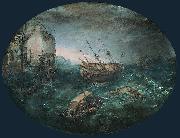 |
Adam Willaerts
|
|
(July 21, 1577, London - April 4, 1664, Utrecht ) was a Dutch Golden Age painter.
Willaerts (occasionally Willarts, Willers) was born in London to Flemish parents who had fled from Antwerp for religious reasons. By 1585 the family lived in Leiden. From 1597 until his death, Adam lived in Utrecht, where he became a member of the Guild of St. Luke in 1611, and subsequently rose to dean in 1620. His sons Cornelis, Abraham, and Isaac followed in his footsteps.
He was known as a painter of river and canal pieces, coastal landscapes, fish-markets, processions, and genre scenes. He also painted villages and marine battle scenes.
|
|
|
|
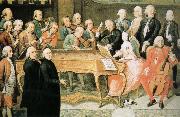 |
adelaide a procter
|
|
an English poet, was the eldest daughter of the poet Bryan Procter.
In 1851, Procter became a Roman Catholic. She took much interest in social questions affecting women. She wrote the well-known songs Cleansing Fires and The Lost Chord, and among her many hymns are I do not ask, O Lord, that Life may be, and My God, I thank Thee who hast made.
|
|
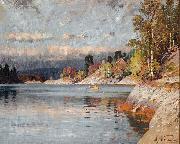 |
Adelsteen Normann
|
|
Adelsteen Normann (1 May 1848 - 26 December 1918) was a Norwegian painter who worked in Berlin. He was a noted painter of landscapes of Norway. Normann was the artist who invited Edvard Munch to Berlin, where he painted The Scream. Normann's fjord paintings are credited with making the Norwegian fjords a more popular tourist destination. |
|
|
|
|
|
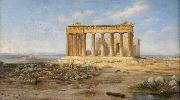 |
Adolf Bohm
|
|
Adolf Böhm
Austria (1861-1927 ) - Painter |
|
|
|
|
|
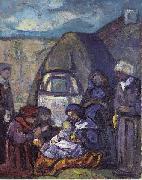 |
Adolf Holzel
|
|
(13 May 1853 - 17 October 1934) was a German artist/painter. His style developed from Impressionism to expressive modernism.
He was born in Olomouc in Moravia, the son of the publisher Eduard Hölzel. In 1871 his family moved to Vienna, and from 1872 he studied painting at the Vienna Academy. He continued his studies in Munich at the Kunstakademie beginning in 1876. There he became acquainted with the painter Fritz von Uhde and painted in a style influenced by Impressionism.
From 1888 to 1905 he worked in Dachau, where there was an artists' colony. Already during his time in Dachau his work began moving toward abstraction, reflecting his interest in such principles as the golden section and Goethe's Theory of Colors. He taught at the Stuttgart Academy, and paintedefour years before Wassily Kandinskyean abstract painting (Composition in Red, 1905). Among his students the so-called "Hölzel circle" developed, including Oskar Schlemmer, Willi Baumeister, Max Ackermann and Johannes Itten. In 1919 Adolf Hölzel left the Stuttgart Academy and went into retirement. He died in Stuttgart in 1934.
|
|
|
|
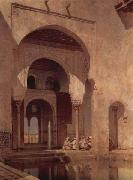 |
Adolf Seel
|
|
(1 March 1829-14 February 1907) was a German painter. He enjoyed training at the Dseldorf Academy of Arts.
Seel visited the academy in Dseldorf in 1844-50, where he trained under Wilhelm Sohn. He then continued to train one year in Paris, spent 1864 and 1865 in Italy, 1870 and 1871 Spain, Portugal and the north coast of Africa as well as 1873 and 1874 the Orient, where he developed his preference for the architecture painting found rich food. Its pieces of architecture, particularly the Arab and Moorish buildings, are usually provided just as beautiful landscapes painted with a masterful perspective, lighting and coloring.
|
|
|
|
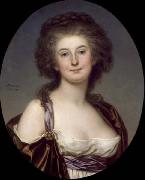 |
Adolf Ulrik Wertmuller
|
|
(February 18, 1751 e October 5, 1811) was a Swedish painter whose notable works include Danaë receiving Jupiter in a Shower of Gold.
Wertmeller was born in Stockholm and studied art at home before moving to Paris in 1772 to study under his cousin Alexander Roslin and French painter Joseph-Marie Vien. On July 30, 1784, Wertmeller was elected to the Royal Academy of Painting and Sculpture.
Wertmeller was commissioned by Gustav III of Sweden for a portrait of Marie Antoinette, which is now in the Nationalmuseum at Stockholm. In 1787, he produced his masterpiece Danaë, a work which proved controversial as one of the earliest female nude paintings exhibited in America.
Wertmeller first emigrated to the United States in May 1794 and continued his portrait work, most notably of General George Washington, but in 1796 was called back to Sweden, eventually returning to Philadelphia in 1800. Elizabeth B. Johnston, in her book Original Portraits of Washington (Boston, 1882), speaks of five portraits of Washington by Wertmeller, of which one, executed in 1797, was purchased by the U. S. government in 1878, and another is owned by the Historical Society of Pennsylvania.
Wertmeller was married to Elizabeth Henderson, granddaughter of noted early American painter Gustavus Hesselius, on January 8, 1801, and two years later retired to a plantation in Claymont, Delaware, where he lived the final years of his life. He died near Marcus Hook, Pennsylvania, aged 60.
|
|
|
|
|
|
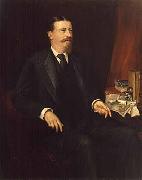 |
Adolfo Muller-Ury
|
|
(March 29, 1862 - July 6, 1947) was a Swiss-born American portrait painter and impressionistic painter of roses and still life.
He was born Felice Adolfo Meller on March 29, 1862 at Airolo, in the Ticino in Switzerland, into a prominent patrician family whose lineage descended from Alfred the Great, Charlemagne and Doge Pietro Orseolo of Venice, through the von Rechburg family (a lady from which family married a Meller) and by the 18th and 19th centuries included mercenaries, lawyers, hoteliers and businessmen. His father was lawyer Carl Alois Meller (1825 - 1887), Gerichtspräsident (Presiding Judge) of the Cantonal Courts, and his mother Genovefa Lombardi (1836 - 1920), daughter of Felice Lombardi who was Director of the Hospice on the St Gotthard Pass, which he took over from the Capuchin monks who had run this for centuries. Adolfo was their sixth of nineteen children, most of whom survived infancy. The family spoke Airolese mainly, a local dialect of Ticinese Italian, as well as Swiss-German. His family were Roman Catholic.
|
|
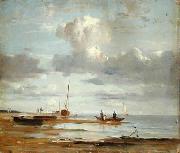 |
Adolph Friedrich Vollmer
|
|
(17 December 1806 - 12 February 1875) was a German landscape and marine painter and graphic artist. He and his contemporary, the painter Christian Morgenstern, were pioneers in Hamburg of early Realism in painting.
As son of a bookkeeper to a Hamburg merchant, Vollmer grew up in humble circumstances.[3] Determined to become a painter against the wishes of his father,[4] he became an apprentice to the brothers Suhr who owned a graphic workshop producing panorama prints. For one and a half years Vollmer travelled throughout Germany with one of the brothers, Cornelius Suhr, as had been Morgenstern before him. In 1826 he was introduced by the Hamburg art-dealer Ernst Harzen to the wealthy aristocrat and supporter of the arts, Carl Friedrich von Rumohr, who was patron to many young Hamburg artists among them Morgenstern and Otto Speckter. Probably on Rumohr advice Vollmer completed his studies under Christoffer Wilhelm Eckersberg at the Royal Danish Academy of Fine Arts in Copenhagen. He then moved to Munich from where he undertook journeys to Lake Konstanz, to the Austrian and Swiss Alps, to Venice, to Le Havre and to the Netherlands.
In 1839 Vollmer returned to Hamburg and settled there. One of his sons, Johannes Vollmer, became a prominent architect of protestant churches; a grand-son was the art historian and encyclopaedist Hans Vollmer who, for many years, edited the Thieme-Becker Kenstler Lexikon.
Vollmer became blind in 1866.
|
|
|
|
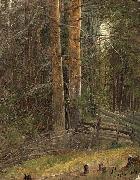 |
Adolph Tidemand
|
|
(1814-1876) was a noted Norwegian romantic nationalism painter. Among his best known paintings are Haugianerne (The Haugeans painted in 1852) and Brudeferd i Hardanger (The Bridal Procession in Hardanger painted in 1848) with Hans Gude.
Adolph Tidemand was born in Mandal, Norway as the son of customs inspector and Storting representative Christen Tidemand (1779-1838) and Johanne Henriette Henrikke Haste (1779-1859). He received private art lessons in his home town and his talent was soon recognized. He then was enrolled in an art school in Christiania, moving on to Copenhagen in the period 1832-37. Upon arrival in Copenhagen, he was rejected by the Royal Danish Academy of Fine Arts and studied at a private school of art, but by 1833 he was a pupil at the Academy, earning Academy exhibitions in 1835 and 1836. He studied there for five years and then began a journey to Italy to study further. But when Tidemand came to Desseldorf, Germany, he liked it so much that he settled down there.
From 1837-1841 he continued his studies with the art academy in Desseldorf, which at the time enjoyed widespread international recognition. He studied with and was influenced by his teacher, Theodor Hildebrandt. |
|
|
|
|
|
|
|
|
|
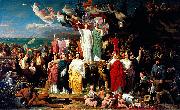 |
Adolphe Yvon
|
|
Adolphe Yvon (1817-1893) was a French painter known for his paintings from the Napoleonic Wars. Yvon studied under Paul Delaroche, rose to fame during the Second Empire, then finished his career as a teacher.
Shortly after the end of the Crimean War in September 1855, Yvon was commissioned by the French government to paint a large picture of the capture of the Malakoff at Sevastopol. He sailed for the Crimea on February 19, 1856 where he spent six weeks compiling a portfolio of sketches, as well as visiting the battlefield of Inkerman. In 1857, the finished painting La Prise de la tour de Malakoff 8 septembre 1855 was shown at the Paris Salon, and two years later came La Gorge de Malakoff, and La courtine de Malakoff. La Prise was a massive piece measuring 6 metres by 9 metres and represented the moment when the fortification was captured around midday.
In the succeeding years, Emperor Napoleon III began to admire his battle scenes; naturally he glorified the carnage of Napoleon I's campaigns. Yvon became an officer of the Legion d'Honneur in 1867, and painted Napoleon III's portrait the following year (unlocated). Yvon was known as the leading teacher of drawing at the Ecole des Beaux-Arts (1863-83). A few Americans received instruction from him, including Christian Schussele, Alfred Wordsworth Thompson, William Sartain, and J. Alden Weir. The latter took Yvon's afternoon life-drawing class starting in the fall of 1874. Yvon provided the subject for compositional sketches for his students, for example, The Assassination of Julius Caesar, for which he specified how it should be done: Caesar covers his head with his toga. |
|
|
|
 |
Adriaan de Lelie
|
|
was born at Tilburg in 1755, and was a scholar of Peeters, a painter of tapestries and ornaments, and afterwards of Quertenmont at Antwerp. He made copies of many of the portraits by Rubens and Van Dyck at Desseldorf, and also of historical pictures by Italian and Dutch masters. By the advice of Professor Camper, he established himself at Amsterdam, where he painted a great number of portraits and cabinet pictures; among the latter is one of the celebrated amateur Jan Gildemeester showing his collection to a party of ladies and gentlemen, in which the principal pictures are readily recognised. One of his best works is that representing the 'Drawing Academy' of the Felix Meritis Society at Amsterdam. His pictures are highly esteemed in Holland and Germany, where they are to be met with in the best collections. He died at Amsterdam in 1820.
|
|
 |
adriaen backer
|
|
the anatomy lesson of dr frederick ruysch,
1670. amsterdams historisch museum |
|
 |
Adriaen Brouwer
|
|
(1605 - January 1638) was a Flemish genre painter active in Flanders and the Dutch Republic in the seventeenth century.
At a young age Brouwer, probably born as Adriaen de Brauwer in Oudenaarde, moved perhaps via Antwerp to Haarlem, where he became a student of Frans Hals alongside Adriaen van Ostade. He also was active in stage acting and poetry. He stayed in Haarlem and Amsterdam until 1631, when he moved back to Antwerp in the Spanish Netherlands. There, he became a member of the Guild of St. Luke in 1631-1632, as well as the rhetoricians's chamber De Violieren.
Tradition has it that Brouwer himself spent much time in the alehouses of Flanders and Holland. His works are typically detailed and small, and often adopt themes of debauchery, drunkenness and foolishness in order to explore human emotions, expressions and responses to pain, fear and the senses. The Bitter Tonic is an example of the type of work that depicts such responses, in this case the sense of taste. His work was well liked, to the point that forgeries were sold in his own time. Both Rubens and Rembrandt owned a number of his works. Nevertheless, Brouwer appeared in financial trouble throughout his life.
He died at the early age of 32 in Antwerp, where he was first buried in a common grave. |
|
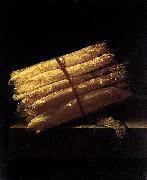 |
Adriaen Coorte
|
|
(ca. 1665 - after 1707) was a Dutch Golden Age painter of still lifes, who signed works between 1683 and 1707. He painted small and unpretentious still lifes in a style more typical of the first half of the century, and was "one of the last practitioners of this intimate category".
Very little is known of his life, but he is assumed to have been born and died in Middelburg. He became a pupil of Melchior d'Hondecoeter around 1680 in Amsterdam. From 1683 he seems to have returned to Middelburg, where he set up a workshop and signed his small, carefully balanced minimalist still lifes. He often painted on paper that was glued to a wooden panel. About 80 signed works by him have been catalogued, and nearly all of them follow the same pattern; small arrangements of fruits, vegetables, or shells on a stone slab, lit from above, with the dark background typical of still lifes earlier in the century. Instead of the Chinese or silver vessels favoured by his contemporaries, his tableware is very basic pottery. "Objects and light are studied intensely, and are painted with a wondrous tenderness".[1] Neither his birth nor death date is certain, and archival evidence only exists in Middelburg for his membership in the Guild of St. Luke there from 1695 onwards, when he was fined for selling a painting without being a member of the guild. His works appear frequently in contemporary Middelburg taxation inventories |
|
|
|
 |
Adriaen Frans Boudewijns
|
|
Adriaan Frans Boudewyns, not Anton Frans (Bauduins, or Baudouin), (3 October 1644 - 3 December 1719) was a Flemish Baroque landscape painter.
He was born at Brussels and learned to paint under a landscape painter named Ignatius van der Stock, and was received into the Guild there in 1665. He then travelled to Paris in 1666 and studied under A. F. van der Meulen for three years, and whose daughter Barbara he married 12 January 1670. In 1674 his wife died and in 1681 he moved back to Brussels where he married again. According to Houbraken he was a good landscape painter who encourage Gerard Hoet to stay in Brussels for 8 months in the 1680s. His son Frans Boudewijns (1682-1767) also became a successful painter. He was ruined in the bombardment of Brussels in 1695.
Adriaen Fransz. Boudewijns, Adriaen Frans Boudewyns, Adriaen Frans Baudewijns, Adriaen Frans Baudewyns, Anton Frans Baudouin, Adriaen Frans Bauduins, Adrien François Bauduins, Monogrammist AFB |
|
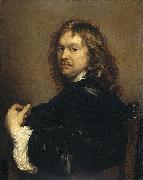 |
Adriaen Hanneman
|
|
(c. 1603 - buried 11 July 1671) was a Dutch Golden Age painter best-known today for his portraits of the exiled British royal court. His style was strongly influenced by his contemporary, Anthony Van Dyck.
|
|
|
|
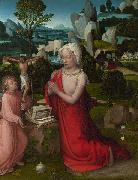 |
Adriaen Isenbrant
|
|
(between 1480 and 1490 - Bruges, July 1551), was a Flemish Northern Renaissance painter, who from documentary evidence was clearly a significant artist of his period, but to whom no specific works can be clearly documented. As hypothesised by art historians, he ran a large workshop specializing in religious subjects and devotional paintings, painting conservatively in the tradition of Early Netherlandish painting. He is believed by some to be the anonymous Master of the Seven Sorrows of the Virgin. Other art historians doubt that any works can be reliably attributed to him, and the number of paintings attributed to him by major museums has been in decline for many decades.
There are only a few documentary records of his life, and some mentions in literature from his lifetime or soon after, but he cannot be documented as the creator of any surviving work; everything else consists of hypothesis. It is possible that he was born in Haarlem or even in Antwerp about 1490. It is not known where or with which painter he served his apprenticeship.
He is named for the first time in 1510, when he came to Bruges and bought his burghership. In November of the same year he already became master in the painterse Guild of St. Luke and the goldsmithse guild of St. Elooi. He was later elected nine time a deacon (in Old Dutch : vinder) and twice the governor (in Old Dutch : gouverneur = treasurer) of the guild.
Soon he had an important workshop, probably in the Korte Vlaminckstraat in Bruges. This was close to the workshop of Gerard David, at the Vlamijncbrugghe and the former workshop of Hans Memling. Bruges, at that time, was one of the richest towns in Europe. Rich traders and merchants ordered diptychs and portraits for personal use. Isenbrandt painted mainly for private clients. However, there were some paintings that were created without any particular commission. He had enough work to even put out work to other painters in Bruges, as a legal suit from 1534 by Isenbrandt against Jan van Eyck (not the famous one) for non-delivery of paintings he had ordered, demonstrates. He was also appointed the agent in Bruges of the painter Adriaan Provoost (son of Jan Provoost), who had moved to Antwerp in 1530. Contemporary sources therefore mention Isenbrandt as a famous and well-to-do painter.
He married twice, the first time with Maria Grandeel, daughter of the painter Peter Grandeel. They had one child. After her death in 1537, he married again in 1547 with Clementine de Haerne. This second marriage resulted in two daughters and a son. He also had an extramarital daughter with the innkeeper Katelijne van Brandenburch (who was at the same the mistress of his friend Ambrosius Benson).
When he died in 1551, he was buried alongside his first wife at the cemetery of the St. Jacob church in Bruges; his children inherited no less than four houses with surrounding property.
|
|
|
|
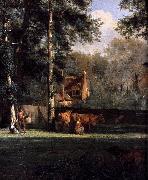 |
Adriaen van de Velde
|
|
(bapt. 30 November 1636, Amsterdam - bur. 21 January 1672, Amsterdam), was a Dutch animal and landscape painter, son of Willem van de Velde the Elder and brother of Willem van de Velde the Younger, the marine painter.
Adriaen did not want to become a marine painter so he was trained in the studio of Jan Wynants, the landscape painter. There he made the acquaintance of Philip Wouwerman, who is believed to have aided him in his studies of animals, and to have exercised a powerful and beneficial influence upon his art. Having made exceptionally rapid progress, he was soon employed by his master to introduce figures into his landscape compositions, and he rendered a similar service to Hobbema, Ruysdael, Verboom and other contemporary artists. According to Houbraken, he died while in collaboration with Jan van der Heyden and Frederik de Moucheron, painting animals on their paintings.[1]
His favourite subjects were scenes of open pasture land, with sheep, cattle and goats, which he executed with dexterity, with much precision of touch and truth of draughtsmanship, and with clear silvery colouring. He painted a few small winter scenes with skaters, and several religious subjects, such as the Descent from the Cross, for a Roman Catholic hidden church in Amsterdam.
In addition to his paintings, of which nearly two hundred have been catalogued, he executed about twenty etchings, several of which appear from their dates to have been done in his fourteenth year. They are distinguished by directness of method and by delicacy and certainty of touch. Van de Velde lived in Kalverstraat, near the Regulierspoort.
|
|
|
|
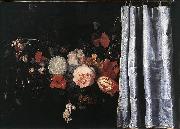 |
Adriaen van der Spelt
|
|
Adriaen van der Spelt (ca. 1630, Leiden - 1673, Gouda), was a Dutch Golden Age flower painter.
According to Houbraken, whose comments were based on the Gouda stories by Ignatius Walvis, he was an excellent flower painter born in Leiden, but his parentage was from Gouda. He spent many years at the court of Brandenburg working for Frederick William I, Elector of Brandenburg, but moved to Gouda to marry a third time with a nasty wife from Groningen who drove him to his grave.
According to the RKD he was a flower painter who spent the years 1664-1670 at the court of Brandenburg. |
|
|








